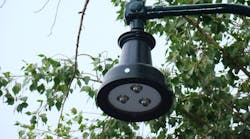The DOE says that the draft criteria have come out now because:
- new products in this category are being introduced regularly
- energy-efficiency programs, municipalities, and other stakeholders have indicated a high level of interest in these applications
- CALiPER testing of market-available luminaires in these categories reveals a wide range of performance
- demonstration projects sponsored by utilities, municipalities, and the DOE GATEWAY program indicate potential for energy savings, but also the need for minimum performance guidelines for these applications
DOE has also developed the fitted target efficacy (FTE) metric (see below) for quantifying outdoor pole-mounted luminaire performance because other existing project-independent metrics did not adequately measure the efficacy that these luminaires will deliver to intended target areas.
Performance criteria
The Proposed Category “A” (near-term applications) additions to the Outdoor Area & Parking Garage area include the below.
1) For outdoor pole-mounted area and roadway luminaires, application requirements are a minimum light output from the luminaire of 1,000 lumens (initial), and a minimum FTE that varies according to whether the luminaires are shielded or unshielded, high output or low.
Luminaire types in this application include but are not limited to luminaires intended for lighting streets, parking lots, walkways, and plazas, and also decorative post-top luminaires. This category excludes luminaires intended to be mounted below eye level, e.g., bollards and steplights.
2) For outdoor wall-mounted area luminaires (“wall packs”), application requirements for minimum light output are 300 lumens (initial), among other metrics.
3) For parking garage/canopy luminaires, application requirements for minimum light output is 2,000 lumens (initial), among other requirements.
Full information on second draft ENERGY STAR performance criteria
DOE invites stakeholder review and comments regarding these second draft criteria by July 31, 2009.
Fitted target efficacy
Two key assumptions underlie the FTE metric. First, relatively rectangular distribution patterns cover most areas more efficiently (with less unnecessary overlap) than rounded distributions. Second, a luminaire’s approximate area of coverage can be defined as the area illuminated to IES-recommended uniformity ratios.
DOE evaluated hundreds of HID luminaire photometric files to establish ENERGY STAR minimum FTE requirements. Minimum FTEs for SSL luminaires in each category were established to achieve at least 20% energy savings compared to top performing incumbent HID products.
Fitted Target Efficacy (FTE) Overview
FTE Algorithm
FTE Calculator Instructions
FTE Calculator




